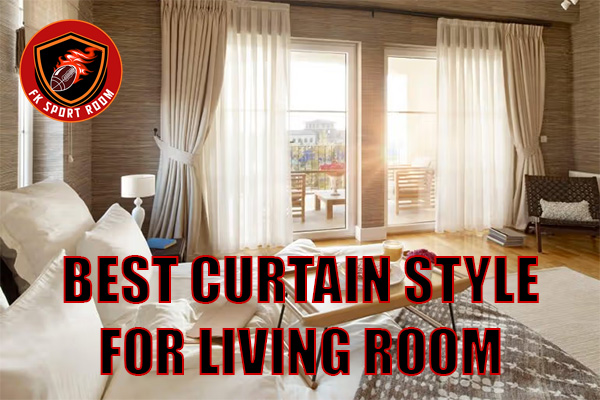Blogs
Best Curtain Style for Living Room: Transform Your Space with Elegance and Comfort
When it comes to living room design, curtains are often the unsung heroes. They don’t just control light and privacy—they frame your windows, set the mood, and tie together your entire décor scheme. Choosing the best curtain style for living room spaces can feel overwhelming, but with the right guidance, you can elevate your room into a stylish, inviting sanctuary.
In this guide, we’ll explore the most popular curtain styles, their pros and cons, plus tips on how to pair them with furniture, lighting, and rugs for a cohesive and stunning look.

Why curtains matter in the living room
Curtains do more than cover your windows. They:
- Add texture, color, and softness to the space
- Influence how natural light filters into the room
- Enhance privacy and comfort
- Balance the proportions of a room by elongating or framing windows
- Serve as a design statement
Best curtain styles for living room
1. Floor-to-ceiling drapes
Why it works: Tall curtains instantly make a room look grander and more sophisticated by drawing the eye upward.
Pros:
- Creates the illusion of higher ceilings
- Luxurious and elegant feel
- Works well with most décor styles
Cons:
- Requires precise measurements
- Can overwhelm small windows if fabric is too heavy
Styling tips:
- Pair with plush rugs and statement lighting (like chandeliers) for a dramatic effect.
- Works beautifully with neutral furniture to balance the bold drapery.
- Use sheer fabrics for a light, airy vibe or velvet for a rich, glamorous look.
2. Sheer curtains
Why it works: Sheers are perfect for letting natural light filter through while maintaining a sense of privacy.
Pros:
- Softens harsh sunlight
- Affordable and versatile
- Adds a breezy, relaxed atmosphere
Cons:
- Doesn’t block much light
- Offers minimal privacy at night
Styling tips:
- Layer with heavier curtains for flexibility—sheer by day, blackout at night.
- Match with light-colored rugs and Scandinavian-inspired furniture for a clean, minimal aesthetic.
- Combine with floor lamps or pendant lights to enhance the ethereal glow.
3. Grommet curtains
Why it works: Sleek and modern, grommet curtains slide easily on the rod, making them a practical and stylish choice.
Pros:
- Easy to open and close
- Contemporary look
- Suitable for casual and modern interiors
Cons:
- Less formal compared to pleated styles
- Limited decorative detailing
Styling tips:
- Perfect with modern sectional sofas and simple coffee tables.
- Pair with geometric rugs and metallic light fixtures for a modern twist.
- Choose bold solid colors for a statement, or neutrals for a minimalist touch.
4. Pleated curtains (Pinch pleat or box pleat)
Why it works: Pleated curtains are timeless, structured, and elegant—great for a classic living room design.
Pros:
- Adds a tailored, polished look
- Works in both traditional and transitional spaces
- Wide variety of pleat styles to choose from
Cons:
- Can be more expensive due to craftsmanship
- Less casual than other curtain styles
Styling tips:
- Best paired with traditional sofas, wooden coffee tables, and patterned rugs.
- Combine with soft, warm lighting like wall sconces for a cozy ambiance.
- Opt for fabrics like linen or silk to enhance sophistication.
5. Roman shades
Why it works: Roman shades are ideal for a neat, streamlined look, especially if you have smaller windows.
Pros:
- Clean and compact design
- Wide range of fabrics and patterns available
- Perfect for layering with drapes
Cons:
- Doesn’t create the same flowing effect as long curtains
- Requires precise fitting for a polished look
Styling tips:
- Pair with minimalist rugs and compact furniture in smaller living rooms.
- Use patterned Roman shades as a focal point if the rest of your room is neutral.
- Great for combining with pendant lights or sconces to emphasize modern simplicity.
6. Layered curtains (Sheer + opaque)
Why it works: Layering offers the best of both worlds—light and airy by day, cozy and private by night.
Pros:
- Maximum flexibility with light control
- Adds depth and texture to the design
- Works well in both modern and classic settings
Cons:
- Requires double rods or a track system
- More fabric means higher cost
Styling tips:
- Style with textured rugs and plush seating for a luxurious vibe.
- Perfect for open-concept living rooms where versatility is key.
- Match layers to your furniture—soft sheers with light sofas, darker panels with bold furniture.
7. Tab-top curtains
Why it works: Casual and charming, tab-top curtains add a laid-back, welcoming feel to any living room.
Pros:
- Easy to hang
- Budget-friendly
- Works great in boho or rustic spaces
Cons:
- Less formal, not ideal for elegant interiors
- Can be tricky to slide open frequently
Styling tips:
- Pair with wooden furniture, textured rugs, and warm, cozy lighting.
- Choose natural fabrics like cotton or linen for a relaxed vibe.
- Accent with colorful cushions or throws to tie the room together.
Pros and cons of using curtains in the living room
Pros:
- Enhance room design and style
- Provide privacy and light control
- Offer flexibility with colors, fabrics, and patterns
- Can be tailored to suit any budget
Cons:
- Need regular cleaning to stay fresh
- Poor measurements can ruin the look
- Some styles may be costly depending on fabric and craftsmanship
How to match curtains with furniture, lighting, and rugs
When styling your curtains, consider the entire room design:
- Furniture: Match curtain tones with sofa cushions or throws for balance. For example, gray curtains pair beautifully with neutral sofas and colorful accent chairs.
- Lighting: Choose curtain fabrics that complement your lighting. Sheers glow beautifully with warm lamps, while heavy fabrics pair well with statement chandeliers.
- Rugs: Use your rug as inspiration for curtain color. A patterned rug can handle solid curtains, while a neutral rug pairs well with bold, patterned drapery.
FAQs about curtain styles for living rooms
1. What curtain style makes a living room look bigger?
Floor-to-ceiling drapes in light fabrics create the illusion of taller ceilings and larger spaces.
2. Are sheer curtains enough for privacy in the living room?
Sheers are great for daytime privacy but should be layered with blackout or opaque curtains for evening coverage.
3. How do I choose curtain colors for my living room?
Match curtain tones with your sofa, rugs, or accent décor. Neutrals are versatile, while bold colors create a statement.
4. What is the most timeless curtain style?
Pleated curtains (like pinch pleats) are classic and elegant, making them a timeless choice for most interiors.
Conclusion
Choosing the best curtain style for living room design is about more than just covering your windows—it’s about creating harmony, balance, and personality in your space. Whether you prefer the drama of floor-to-ceiling drapes, the lightness of sheers, or the elegance of pleated curtains, the right choice can completely transform your home.
Start by considering your living room’s size, lighting, and overall décor style. Then, pick a curtain style that complements—not competes—with the rest of your design. With the right curtains, your living room will feel like a stylish retreat filled with warmth and comfort.
✨ The right curtains don’t just decorate—they define your living room.
